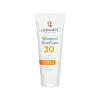What's inside
What's inside
 Key Ingredients
Key Ingredients

 Benefits
Benefits

 Concerns
Concerns

 Ingredients Side-by-side
Ingredients Side-by-side

Water
Skin ConditioningCyclopentasiloxane
EmollientAscorbyl Tetraisopalmitate
AntioxidantNiacinamide
SmoothingEthylhexyl Stearate
EmollientGlycerin
HumectantCetyl Alcohol
EmollientGlyceryl Stearate
EmollientHydrogenated Polydecene
EmollientSodium PCA
HumectantCetearyl Alcohol
EmollientPEG-75 Stearate
Caprylyl Glycol
EmollientTocopherol
AntioxidantSodium Hyaluronate
HumectantSodium Carboxymethyl Betaglucan
Ergothioneine
AntioxidantCeteth-20
CleansingSteareth-20
CleansingP-Anisic Acid
MaskingHydroxyethyl Acrylate/Sodium Acryloyldimethyl Taurate Copolymer
Emulsion StabilisingSqualane
EmollientXanthan Gum
EmulsifyingSorbitan Isostearate
EmulsifyingPolysorbate 60
EmulsifyingWater, Cyclopentasiloxane, Ascorbyl Tetraisopalmitate, Niacinamide, Ethylhexyl Stearate, Glycerin, Cetyl Alcohol, Glyceryl Stearate, Hydrogenated Polydecene, Sodium PCA, Cetearyl Alcohol, PEG-75 Stearate, Caprylyl Glycol, Tocopherol, Sodium Hyaluronate, Sodium Carboxymethyl Betaglucan, Ergothioneine, Ceteth-20, Steareth-20, P-Anisic Acid, Hydroxyethyl Acrylate/Sodium Acryloyldimethyl Taurate Copolymer, Squalane, Xanthan Gum, Sorbitan Isostearate, Polysorbate 60
Water
Skin ConditioningZinc Oxide
Cosmetic ColorantEthylhexyl Stearate
EmollientCaprylic/Capric Triglyceride
MaskingIsostearyl Isostearate
EmollientCetearyl Alcohol
EmollientGlycerin
HumectantPolyglyceryl-3 Methylglucose Distearate
EmulsifyingSucrose Stearate
EmollientCoco-Caprylate
EmollientCocos Nucifera Oil
MaskingCaprylyl Glycol
EmollientIsostearic Acid
CleansingLecithin
EmollientPolyhydroxystearic Acid
EmulsifyingPolyglyceryl-3 Polyricinoleate
EmulsifyingXanthan Gum
EmulsifyingGlyceryl Caprylate
EmollientPropanediol
SolventTocopherol
AntioxidantWater, Zinc Oxide, Ethylhexyl Stearate, Caprylic/Capric Triglyceride, Isostearyl Isostearate, Cetearyl Alcohol, Glycerin, Polyglyceryl-3 Methylglucose Distearate, Sucrose Stearate, Coco-Caprylate, Cocos Nucifera Oil, Caprylyl Glycol, Isostearic Acid, Lecithin, Polyhydroxystearic Acid, Polyglyceryl-3 Polyricinoleate, Xanthan Gum, Glyceryl Caprylate, Propanediol, Tocopherol
Ingredients Explained
These ingredients are found in both products.
Ingredients higher up in an ingredient list are typically present in a larger amount.
Caprylyl Glycol is a humectant and emollient, meaning it attracts and preserves moisture.
It is a common ingredient in many products, especially those designed to hydrate skin. The primary benefits are retaining moisture, skin softening, and promoting a healthy skin barrier.
Though Caprylyl Glycol is an alcohol derived from fatty acids, it is not the kind that can dry out skin.
This ingredient is also used as a preservative to extend the life of products. It has slight antimicrobial properties.
Learn more about Caprylyl GlycolCetearyl alcohol is a mixture of two fatty alcohols: cetyl alcohol and stearyl alcohol. It is mainly used as an emulsifier. Emulsifiers help prevent the separation of oils and products. Due to its composition, it can also be used to thicken a product or help create foam.
Cetearyl alcohol is an emollient. Emollients help soothe and hydrate the skin by trapping moisture.
Studies show Cetearyl alcohol is non-toxic and non-irritating. The FDA allows products labeled "alcohol-free" to have fatty alcohols.
This ingredient is usually derived from plant oils such as palm, vegetable, or coconut oils. There is debate on whether this ingredient will cause acne.
Due to the fatty acid base, this ingredient may not be Malassezia folliculitis safe.
Learn more about Cetearyl AlcoholEthylhexyl Stearate is an ester of 2-ethylhexyl alcohol and stearic acid. It is an emulsifier, emollient, and texture enhancer.
As an emulsifier, it helps prevent ingredients from separating.
Its emollient property helps soften and hydrate the skin. Emollients form a barrier on the skin to trap moisture in.
Learn more about Ethylhexyl StearateGlycerin is already naturally found in your skin. It helps moisturize and protect your skin.
A study from 2016 found glycerin to be more effective as a humectant than AHAs and hyaluronic acid.
As a humectant, it helps the skin stay hydrated by pulling moisture to your skin. The low molecular weight of glycerin allows it to pull moisture into the deeper layers of your skin.
Hydrated skin improves your skin barrier; Your skin barrier helps protect against irritants and bacteria.
Glycerin has also been found to have antimicrobial and antiviral properties. Due to these properties, glycerin is often used in wound and burn treatments.
In cosmetics, glycerin is usually derived from plants such as soybean or palm. However, it can also be sourced from animals, such as tallow or animal fat.
This ingredient is organic, colorless, odorless, and non-toxic.
Glycerin is the name for this ingredient in American English. British English uses Glycerol/Glycerine.
Learn more about GlycerinTocopherol (also known as Vitamin E) is a common antioxidant used to help protect the skin from free-radicals and strengthen the skin barrier. It's also fat soluble - this means our skin is great at absorbing it.
Vitamin E also helps keep your natural skin lipids healthy. Your lipid skin barrier naturally consists of lipids, ceramides, and fatty acids. Vitamin E offers extra protection for your skin’s lipid barrier, keeping your skin healthy and nourished.
Another benefit is a bit of UV protection. Vitamin E helps reduce the damage caused by UVB rays. (It should not replace your sunscreen). Combining it with Vitamin C can decrease sunburned cells and hyperpigmentation after UV exposure.
You might have noticed Vitamin E + C often paired together. This is because it is great at stabilizing Vitamin C. Using the two together helps increase the effectiveness of both ingredients.
There are often claims that Vitamin E can reduce/prevent scarring, but these claims haven't been confirmed by scientific research.
Learn more about TocopherolWater. It's the most common cosmetic ingredient of all. You'll usually see it at the top of ingredient lists, meaning that it makes up the largest part of the product.
So why is it so popular? Water most often acts as a solvent - this means that it helps dissolve other ingredients into the formulation.
You'll also recognize water as that liquid we all need to stay alive. If you see this, drink a glass of water. Stay hydrated!
Learn more about WaterXanthan gum is used as a stabilizer and thickener within cosmetic products. It helps give products a sticky, thick feeling - preventing them from being too runny.
On the technical side of things, xanthan gum is a polysaccharide - a combination consisting of multiple sugar molecules bonded together.
Xanthan gum is a pretty common and great ingredient. It is a natural, non-toxic, non-irritating ingredient that is also commonly used in food products.
Learn more about Xanthan Gum